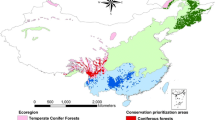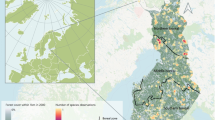Abstract
Protected areas (PAs) play an important role in the conservation of valuable forest resources, and an increasing number of areas are being designated as PAs worldwide. However, climate change could drive endangered forest plants out of PAs, and impact the function of PAs to conserve endangered forest plants. Hence, it is necessary for conservation biologists to put forward a simple method to evaluate the ability of PAs to conserve endangered forest plants. Here, we studied 61 endangered forest plants from three ecoregions in China. We applied species distribution modeling to project suitable habitats of endangered forest plants, and used geographical information system to compute whether PAs could support the conservation of endangered forest plants. With climate change caused by increasing gas concentration, the overall ability of PAs to support the conservation of endangered forest plants will likely decrease compared to the conservation needs of ecoregions. We found that PAs have varying abilities to conserve endangered forest plants in different ecoregions. For temperate broadleaf mixed forests and tropical and subtropical moist broadleaf forests, we found that climate change will decrease the PAs’ ability to support the conservation of endangered forest plants effectively in the existing forest landscape. In contrast, we found that temperate conifer forests will likely remain effective. Using this information, we proposed the conservation plans for different ecoregions under climate change. For PAs with limited ability to support the conservation of endangered forest plants in an ecoregion, we recommend expanding the areas of forests and PAs based on the suitable habitats of the endangered forest plants. For PAs with stable ability to support the conservation of endangered forest plants in an ecoregion, we recommend expanding the conservation areas in PAs.



Similar content being viewed by others
References
Adams HD, Guardiola-Claramonte M, Barron-Gafford GA, Villegas JC, Breshears DD, Zou CB, Troch PA, Huxman TE (2009) Temperature sensitivity of drought-induced tree mortality portends increased regional die-off under global change type drought. Proc Natl Acad Sci USA 106:7063–7066
Alagador D, Martins MJ, Cerdeira JO, Cabeza M, Araújo MB (2011) A probability-based approach to match species with reserves when data are at different resolutions. Biol Conser 144:811–820
Allen CD, Macalady AK, Chenchouni H, Bachelet D, McDowell N, Vennetier M, Kitzberger T, Rigling A, Breshears D, Hogg E, Gonzalez P, Fensham R, Zhang Z, Castro J, Demidova N, Lim J, Allard G, Running S, Semerci A, Cobb N (2010) A global overview of drought and heat-induced tree mortality reveals emerging climate change risks for forests. For Ecol Manag 259:660–684
Andam KS, Ferraro PJ, Pfaff A, Sanchez-Azofeifa GA, Robalino JA (2008) Measuring the effectiveness of protected area networks in reducing deforestation. Proc Natl Acad Sci USA 105:16089–16094
Andrello M, Jacobi MN, Manel S, Thuiller W, Mouillot D (2014) Extending networks of protected areas to optimize connectivity and population growth rate. Ecography. doi:10.1111/ecog.00975
Araujo MB, Guisan A (2006) Five (or so) challenges for species distribution modelling. J Biogeogr 33:1677–1688
Araújo MB, Alagador D, Cabeza M, Nogués-Bravo D, Thuiller W (2011) Climate change threatens European conservation areas. Ecol Lett 14:484–492
Arino O, Ramos Perez J, Kalogirou V, Bontemps S, Defourny P, Van Bogaert E (2012) Global land cover map for 2009 (GlobCover 2009)
Brown HCP, Smit B, Somorin OA, Sonwa DJ, Nkem JN (2014) Climate Change and Forest Communities: prospects for Building Institutional Adaptive Capacity in the Congo Basin Forests. Ambio 43:759–769
Calabrese JM, Certain G, Kraan C, Dormann CF (2014) Stacking species distribution models and adjusting bias by linking them to macroecological models. Glob Ecol Biogeogr 23:99–112
Corlett RT, Westcott DA (2013) Will plant movements keep up with climate change? Trends Ecol Evol 28:482–488
D’Amen M, Bombi P, Pearman PB, Schmatz DR, Zimmermann NE, Bologna MA (2011) Will climate change reduce the efficacy of protected areas for amphibian conservation in Italy? Biol Conserv 144:989–997
Danese M, Lazzari M, Murgante B (2008) Kernel density estimation methods for a geostatistical approach in seismic risk analysis: the case study of potenza hilltop town (Southern Italy). In: Computational science and its applications—ICCSA 2008. Springer, Berlin, pp 415–429
DeFries R, Hansen A, Newton AC, Hansen MC (2005) Increasing isolation of protected areas in tropical forests over the past twenty years. Ecol Appl 15:19–26
Elith J, Phillips SJ, Hastie T, Dudík M, Chee YE, Yates CJ (2011) A statistical explanation of MaxEnt for ecologists. Divers Distrib 17:43–57
Gallagher RV, Hughes L, Leishman MR (2012) Species loss and gain in communities under future climate change: consequences for functional diversity. Ecography 36:531–540
Gillson L, Dawson TP, Jack S, McGeoch MA (2013) Accommodating climate change contingencies in conservation strategy. Trends Ecol Evol 28:135–142
Goldenshluger A, Lepski O (2011) Bandwidth selection in kernel density estimation: oracle inequalities and adaptive minimax optimality. Ann Stat 39:1608–1632
Gormley AM, Forsyth DM, Griffioen P, Lindeman M, Ramsey DS, Scroggie MP, Woodford L (2011) Using presence-only and presence–absence data to estimate the current and potential distributions of established invasive species. J Appl Ecol 48:25–34
Hanewinkel M, Cullmann DA, Schelhaas MJ, Nabuurs GJ, Zimmermann NE (2013) Climate change may cause severe loss in the economic value of European forest land. Nat Clim Change 3:203–207
Hannah L, Midgley GF, Millar D (2002) Climate change-integrated conservation strategies. Glob Ecol Biogeogr 11:485–495
Harte J, Ostling A, Green JL, Kinzig A (2004) Biodiversity conservation: climate change and extinction risk. Nature. doi:10.1038/nature02718
Hernandez PA, Graham CH, Master LL, Albert DL (2006) The effect of sample size and species characteristics on performance of different species distribution modeling methods. Ecography 29:773–785
Hou X (2001) Vegetation atlas of China. Chinese Academy of Science, The Editorial Board of Vegetation Map of China. Scientific Press, Beijing
IPCC (2013) Climate Change 2013: The Physical Science Basis. Contribution of Working Group I to the Fifth Assessment Report of the Intergovernmental Panel on Climate Change [Stocker, T.F., D. Qin, G.-K. Plattner, M. Tignor, S.K. Allen, J. Boschung, A. Nauels, Y. Xia, V. Bex and P.M. Midgley (eds.)]. Cambridge University Press, Cambridge, United Kingdom and New York
Kim HG, Lee DK, Park C, Kil S, Son Y, Park JH (2015) Evaluating landslide hazards using RCP 4.5 and 8.5 scenarios. Environ Earth Sci 73:1385–1400
Lindborg R, Eriksson O (2004) Historical landscape connectivity affects present plant species diversity. Ecology 85:1840–1845
Loiselle BA, Howell CA, Graham CH, Goerck JM, Brooks T, Smith KG, Williams PH (2003) Avoiding pitfalls of using species distribution models in conservation planning. Conserv Biol 17:1591–1600
Mamet SD, Chun KP, Metsaranta JM, Barr AG, Johnstone JF (2015) Tree rings provide early warning signals of jack pine mortality across a moisture gradient in the southern boreal forest. Environ Res Lett 10:084021
Merow C, Smith MJ, Silander JA (2013) A practical guide to MaxEnt for modeling species’ distributions: what it does, and why inputs and settings matter. Ecography 36:1058–1069
Millar CI, Stephenson NL, Stephens SL (2007) Climate change and forests of the future: managing in the face of uncertainty. Ecol Appl 17:2145–2151
Moilanen A, Anderson BJ, Arponen A, Pouzols FM, Thomas CD (2013) Edge artefacts and lost performance in national versus continental conservation priority areas. Divers Distrib 19:171–183
Olson M, Dinerstein E, Wikramanayake D, Burgess D, Powell G, Underwood E, D’amico J, Itoua I, Strand H, Morrison J, Loucks C, Allnutt T, Ricketts T, Kura Y, Lamoreux J, Wettengel W, Hedao P, Kassem K (2001) Terrestrial ecoregions of the world: a new map of life on Earth a new global map of terrestrial ecoregions provides an innovative tool for conserving biodiversity. Bioscience 51:933–938
Park NW (2015) Using maximum entropy modeling for landslide susceptibility mapping with multiple geoenvironmental data sets. Environ Earth Sci 73:937–949
Peterson AT, Li X (2014) Niche-based projections of wetlands shifts with marine intrusion from sea level rise: an example analysis for North Carolina. Environ Earth Sci 73:1479–1490
Ponce-Reyes R, Reynoso-Rosales VH, Watson JE, VanDerWal J, Fuller RA, Pressey RL, Possingham HP (2012) Vulnerability of cloud forest reserves in Mexico to climate change. Nat Clim change 2:448–452
Pretty J, Smith D (2004) Social capital in biodiversity conservation and management. Conserv Biol 18:631–638
Steneck RS, Graham MH, Bourque BJ, Corbett D, Erlandson JM, Estes JA, Tegner MJ (2002) Kelp forest ecosystems: biodiversity, stability, resilience and future. Environ Conserv 29:436–459
Thomas CD (2011) Translocation of species, climate change, and the end of trying to recreate past ecological communities. Trends Ecol Evol 26:216–221
Wan J, Wang C, Han S, Yu J (2014) Planning the priority protected areas of endangered orchid species in northeastern China. Biodivers Conserv 23:1395–1409
Wang C, Wan J, Mu X, Zhang Z (2015) Management planning for endangered plant species in priority protected areas. Biodivers Conserv 24:2383–2397
Warren R, Price J, Fischlin A, de la Nava SantosS, Midgley G (2011) Increasing impacts of climate change upon ecosystems with increasing global mean temperature rise. Clim Change 106:141–177
Wise RM, Reyers B, Guo C, Midgley GF, De Lange W (2012) Costs of expanding the network of protected areas as a response to climate change in the cape floristic region. Conserv Biol 26:397–407
Yin Y, Liu H, Liu G, Hao Q, Wang H (2013) Vegetation responses to mid-Holocene extreme drought events and subsequent long-term drought on the southeastern Inner Mongolian Plateau, China. Agric For Meteorol 178:3–9
Yu J, Wang C, Wan J, Han S, Wang Q, Nie S (2014) A model-based method to evaluate the ability of nature reserves to protect endangered tree species in the context of climate change. For Ecol Manag 327:48–54
Zhang MG, Zhou ZK, Chen WY, Cannon CH, Raes N, Slik JW (2014) Major declines of woody plant species ranges under climate change in Yunnan, China. Divers Distrib 20:405–415
Zhang Z, Yan Y, Tian Y, Li J, He JS, Tang Z (2015) Distribution and conservation of orchid species richness in China. Biol Conserv 181:64–72
Zome RJ, Xu J, Wang M, Trabucco A, Li Z (2015) Projected impact of climate change on the effectiveness of the existing protected area network for biodiversity conservation within Yunnan Province, China. Biol Conserv 184:335–345
Acknowledgments
This research was supported by the project entrusted to the Protection Division under the State Forestry Bureau, “Investigation and in situ conservation of Pyrus hopeiensis, the plant species with extremely small populations” (2) and the Fundamental Research Funds for the Central Universities (BLYJ201501). We thank the following National Nature Reserves for the use of their species data: Banqiao, Gujingyuan, Qingliangfeng, Songshan, Daiyunshan, E’meifeng, Longqishan, Minjianghekoushidi, Minjiangyuan, Tingjiangyuan, Xiongjianghuangchulin, Zhangjiangkouhongshulinshidi, Gansulianhuashan, Qinzhouzhenxishuishengyeshengdongwu, Taizishan, Yuhe, Haifengniaolei, Lianzhoutianxin, Luokeng’exi, Shimentai, Xiangtoushan, Yunkaishan, Bangliangchangbiyuan, Chongzuobaitouyehou, Daguishan’exi, Dayaoshan, Encheng, Fangchengjinhuacha, Huaping, Jiuwanshan, Qichong, Shiwandashan, Yinzhulaoshanziyuanlengshan, Yuanbaoshan, Dashahe, Fodingshan, Leigongshan, Yinggeling, Changlihuangjinhaian, Hengshuihu, Qingyazhai, Tuoliang, Xiaowutaishan, Baotianman, Henandabieshan, Gaoleshan, Huangheshidi, Jigongshan, Beijicun, Zhuonahe, Daxiagu, Mudanjiangdongbeihu, Dongfanghong, Duobuku’er, Fenglin, Heilongjiangfenghuangshan, Gongbielahe, Lingfeng, Maolangou, Mingshui, Mudanfeng, Pingdingshan, Qixingdongbeihu, Sanhuanpao, Shankou, Taipinggou, Wuyiling, Wuyu’erhe, Wudalianchi, Xiaobeihu, Xinqingbaitouhe, Youhao, Zhongyangzhanheizuisongji, Badongjinsihou, Duheyuan, Hubeidabieshan, Mulinzi, Nanhe, Qizimeishan, Saiwudang, Sanxiadalaoling, Shennongjia, Shibalichangxia, Wudaoxia, Xianfengzhongjianhedani, Xingdoushan, Yerengou, Baiyunshan, Dong’anshunhuangshan, Dongdongtinghu, Gaowangjie, Hupingshan, Jintongshan, Jiuyishan, Wuyunjie, Xidongtinghu, Baishanyuanshe, Boluohu, Hunchundongbeihu, Ji’an, Jingyu, Shihu, Wangqing, Yanminghu, Dafengmilu, Yanchengshidizhenqin, Ganjiangyuan, Jiulingshan, Lushan, Qiyunshan, Tongboshan, Wuyuansenlinniaolei, Yangjifeng, Bailiangshan, Daheishan, Hongluoshan, Louzishan, Nulu’erhushan, Qinglonghe, Shedaolaotieshan, Yalujiangkoushidi, Zhanggutai, A’lu, Bilahe, Gaogesitaihanwula, Hanshan, Hanma, Qingshan, Wulanba, Datongbeichuanheyuanqu, Huanghesanjiaozhou, Nansihu, Heichashan, Lingkongshan, Guanyinshan, Hanchenghuanglongshanhemaji, Huangbaiyuan, Huanglongshanhemaji, Luoyangzhenxishuishengdongwu, Micangshan, Motianling, Pingheliang, Taibaishan, Taibaixushuihe, Wuliangshan, Zhouzhilaoxiancheng, Anzihe, Baihe, Caopo, Gexigou, Heizhugou, Jiudingshan, Laojunshan, Liziping, Nuoshuihezhenxishuishengdongwu, Qianfoshan, Xiaozhaizigou, Xuebaoding, Ailaoshan, Daweishan, Jiaozishan, Lvchunhuanglianshan, Nan’gunhe, Tongbiguan, Wenshan, Wumengshan, Yuanjiang, Yunlongtianchi, Jiushanliedao, Wuyanling, Changxingyangzi’e, Dabashan, Jinfoshan, Wulipo, and Xuebaoshan.
Author information
Authors and Affiliations
Corresponding author
Electronic supplementary material
Below is the link to the electronic supplementary material.
Rights and permissions
About this article
Cite this article
Wang, CJ., Wan, JZ., Zhang, GM. et al. Protected areas may not effectively support conservation of endangered forest plants under climate change. Environ Earth Sci 75, 466 (2016). https://doi.org/10.1007/s12665-016-5364-4
Received:
Accepted:
Published:
DOI: https://doi.org/10.1007/s12665-016-5364-4




